Tell us a little bit about yourself and what you do.
Hi! My name is Wade and I’m a digital anthropologist from Silicon Valley. I’m the founder of my own digital art space, Silicon Valet, the co-director of a physical gallery space, Transfer Gallery, and I also serve as the technology curator for the Consulate of Canada in San Francisco! By day I work for a foreign government on technology diplomacy initiatives, and by night I curate digital art 
How did your interest in online curation begin?
I got into digital curation because I was fascinated with the concept of a personal digital device becoming an exhibition space. I find that there is something profoundly powerful and intimate about hosting an artwork on your computer or phone and having a one-to-one physical relationship with it. I was deeply inspired by Paul Soulellis’s The Download series of ZIP file exhibitions for Rhizome.org. I thought it was amazing that you could contain an entire show in a file, download and host it on your computer, and turn your desktop into a show room. I found myself building stronger attachments to these artworks, and spending more time with them than I might in a public gallery space.
I curated my first online exhibition for Off Site Project in 2018. The show was called ‘The Finder,’ and I asked artists to submit virtual tours of their virtual studios (aka, their desktops). The resulting show is a super intimate experience where the artists’ desktops get downloaded on to the viewers’ desktops, and their personal spaces become intermingled. Like I said, I was obsessed with this concept!
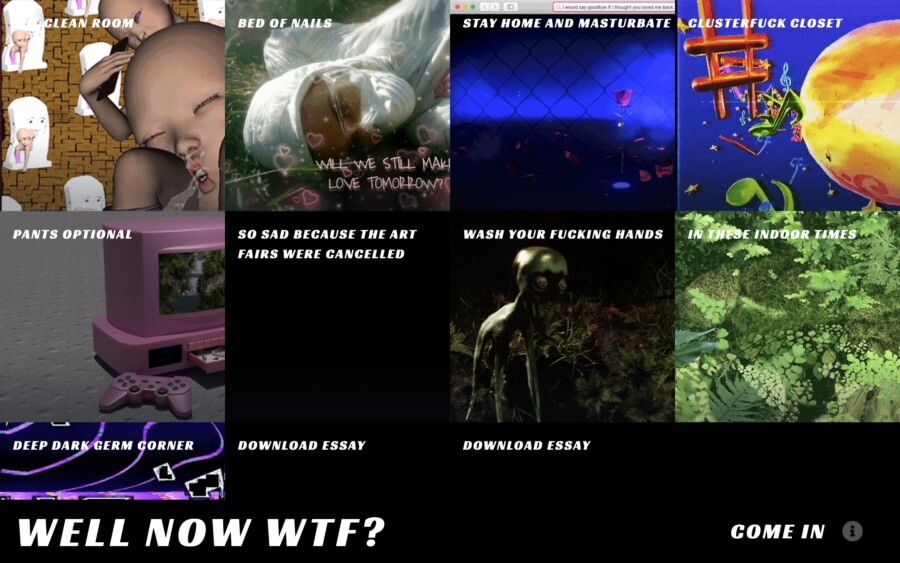
Still from Well Now WTF?
What are some recent, upcoming or current projects you are working on?
Right now I’m working on an exhibition for Silicon Valet with Lorna Mills and Faith Holland — two amazing net artists that I’ve had the privilege of collaborating with over the years. We had been reading about in the art mags about a ‘net art revival’ that is supposedly happening due to the global quarantine conditions, and felt a bit annoyed. Like, we’ve been here! Doing this work! For a long time! Now, suddenly because everyone is bored and at home and online folks are finally paying attention?
We felt that we wanted to repurpose this moment. Rather than a net art revival, we see this as a moment to reclaim net art and re-light the fire of net community that was born in the 90s. We also wanted to respond to the existential dread of COVID-19 in a way that didn’t feel pedantic. We titled the show “Well Now WTF?” to describe this existential feeling that feels, well, pretty universal right now. There are no solutions from this site or lessons to be learned — but there are raw emotions, rendered in gifs, that the 90+ artists in the show are sharing with the world.
Most importantly, the show is built to be a community hub. There is a chat room that runs persistently across all of the pages containing the show, where the audience can interact with each other and the artists. We’re planning a huge slate of online public programming, that will directly involve the audience in old school chat room style vibes. The whole thing is kicking off with a huge virtual opening party on April 4th, where we’ll live stream a Zoom chat with all of the artists and open up the chat room for the first time. There are some well established artists right alongside brand new emerging artists in the show; we tried to represent as many age groups and physical localities as possible to really coalesce the entire global community. We hope the show might serve as a starting point for community organization, and hope to keep the energy alive for as long as we can. I’m excited to see what tentacles and creative collaborations emerge out of this bringing together of soooo many different talents from all over the world.
What freedoms and limitations do you have as an exclusively digital platform?
I’m only limited by my hardware capacity and my coding knowledge. For someone with a lot of knowledge about digital art, I don’t have a lot of hard computer skills which has been a bit of a challenge for me. That said, I can do whatever I want whenever I want it at whatever scale I want to do it in. I don’t need to rely on handlers or tricky installations ~~ I can simply create whatever I want digitally and make it live when I’m ready to share with the world.
That said, digital spaces do confront a lot of blockades in our contemporary digital paradigm. For one, the visibility of my gallery is directly related to my ability to game the algorithms: to post in such a way that I garner as much attention as possible. No matter what, I’m subject to the algorithmic infrastructure of the platforms I use. I’m only as good as my search engine optimization. On Instagram, my posts are only shown to a fraction of my audience. It’s a constant fight for attention and engagement, and there are a lot of other spaces that I’m competing with.
At the same time, I’m also limited by the devices of my viewers. I can’t know how my viewers are checking out what I’m posting. The number of receiving interface configurations is almost infinitely variable. If I create something on the web, will it work when a viewer tries to load it on their phone? Perhaps they use Firefox instead of Chrome, and each browsing software displays Silicon Valet differently. I could create the most elaborate, complex, and immersive digital experience ever. But, if my viewers can’t check it out easily, what’s the point?
These two factors: algorithmic environments and interface configurations, are the two biggest hurdles that any digital platform has to overcome.
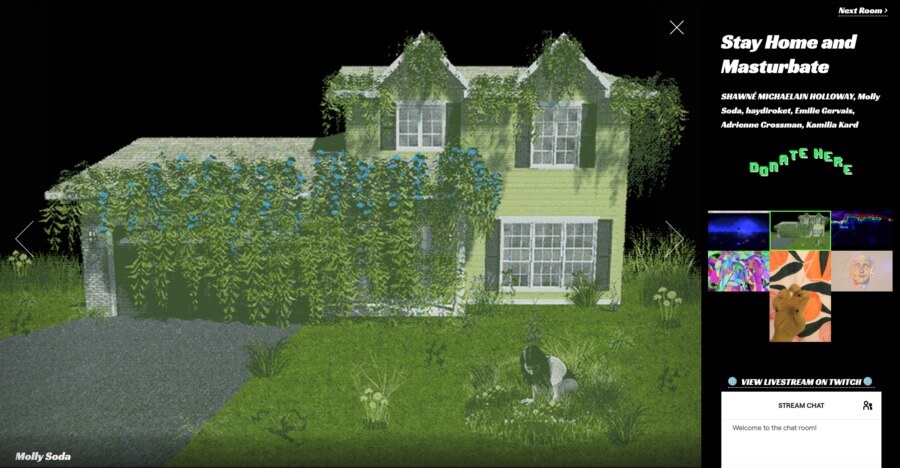
What is your curation process?
My process is deeply informal. I start out with shit that I like. Work that hits home for some reason. If I find myself thinking about a work after I’ve seen it but can’t put my finger on why, I try to really tap into that feeling. That feeling of unknowing, or of raw affective energy, is usually where my creative process begins.
I also often work collaboratively, and find this an inspiring place to start from. I curate with my friends, and with the spaces and projects that inspire me. We start a conversation, and keep spitballing ideas until something takes shape. Generally, there’s a question that someone poses that everyone involved finds interesting or confusing. We start researching, and piece by piece chip away at our metaphorical piece of marble until we can see the form of the show. I think that collective action is a powerful way to work, especially in our networked society. There is no need to be, or work, alone in the age of hypermedia.
The mechanisms of our society are deeply inspiring to me, and my curatorial process often emulates broader macro & micro structures of our contemporary world. Modern modes of organization in digital culture have a heavy hand in shaping all of my curatorial work.
How is Silicon Valet particularly relevant during the Covid-19 pandemic?
We are relevant because we provide access to virtual art experiences in a time when physical gallery visiting is not possible. We share exhibitions and happenings that have some connection to digital technologies, some more loosely than others, in an effort to centralize the global distribution of digital art cultures. Folks who can’t travel the world to see exciting new media installations can have meaningful experiences and engagements via Silicon Valet.
More importantly, we aim to build community. We don’t just dump shows on an instagram page, we curate conversations between artists and try to build bridges wherever we can. The ultimate goal is to pop the filter bubbles that separate us (us being all of us in the global digital arts community). We use informal language to create casual environments for conversation, host an online artist residency, and are now expanding to host our own exhibitions. With everyone stuck indoors, we need spaces to communicate and come together. It’s important that we stay aware of what’s going on in our community, and serve as a communicative curatorial resource. Like a living archive, exhibition space, and community forum all rolled into one.
What is one of the bigger challenges you and/or other curators are struggling with and how do you see it developing?
Right now, I think the biggest issue facing digital platforms is funding. This is a new frontier, or at least a new-ish frontier: one that the financial mechanisms of the larger Art World have yet to adapt to. It’s hard to secure grant money, or sponsorship from major institutions.
Digital artists and curators are slowly adopting new practices to earn money and make ends meet. I find some of the most exciting examples when digital practitioners adapt the practices of ‘influencers’ to their own online personas. This can include doing sponsored posts with brands, hosting advertising on their websites, or organizing fan bases via Patreon or GoFundMe. It’s hard though — without the right amount of social media clout earning a serious income this way is difficult. A lot of people see this as “selling out” or as diluting an artist’s practice. I call it adapting to survive.
Silicon Valet is currently totally unfunded. It’s just me, building the gallery and working with artists who have the spare time to work with me. I try to use my training as a digital anthropologist to create enriching programming for artists, and use my marketing and PR experience to teach self-promotion tools and provide visibility, but I’d really like to find a way to provide them with robust financial compensation. This is a work in progress, and Silicon Valet is just a fledgling project still. It’s tough out there.
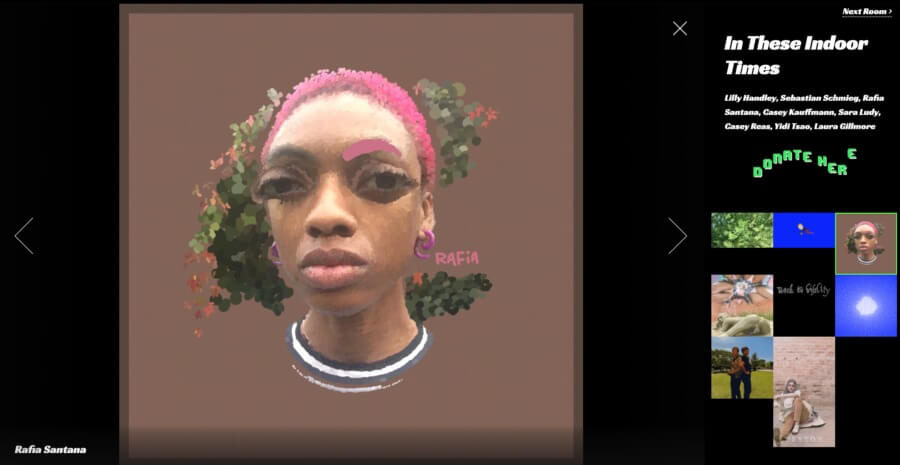
Who would you most like to collaborate with?
Right now my biggest curatorial crush is Julia Greenway! We’ve become internet friends recently and did an instagram live chat together on Silicon Valet this week. She’s a super genius, who often works to take digital-native work and translate it into physical environments. Her most recent exhibitions – one with Gery Georgieva at Cubitt Gallery in London and one with Joey Holder in collaboration with Harlesden High Street Gallery, Seventeen Gallery, and the Zabludowicz collection – are not only stunning but academically rigorous presentations of research-intensive new media installations. Love her, sick vibes, currently looking for a space to host what I’m sure will be a legendary collab.
What are you really excited about right now?
I love all of the new digital exhibitions that have been popping up left and right since global lock down began. It’s really exciting to see other people getting into something that I’ve been so passionate about for so long. I hope to continue to use Silicon Valet to introduce new folks to the world of digital art, and also welcome newcomer platforms to the wider community. The amount of engagement and interaction I’ve been having across my personal and business social media accounts recently is astounding. It reminds me of what the web used to feel like back in 00’s. Have had so many interesting conversations, which have sparked a whole slate of cool projects with creative folks all over the world. Some insanely amazing stuff is going to come out of this bizarre period in history.
There’s an incredible energy on the net right now — and everything that I’m doing right now is in efforts to harness and direct that energy. I hope that the COVID-19 crisis mellows out soon, but that we can preserve this momentum as long as we can.
What was the last exhibition you saw that stuck out to you?
I loved Chris Dorland’s IRL/URL exhibition at Nicoletti Contemporary, which is a new physical and digital contemporary art space in London run by Oswaldo Nicoletti. Their virtual gallery is sick! I thought both the physical installation and virtual experience really complemented each other. nicely It was smooth, sharp, and deeply immersive. In general, Oswaldo is running a really exciting program and will definitely continue to keep on eye on what they’re up to.
YPuccko Gallery runs by Nico Lillo is another awesome virtual gallery space. I loved their Wrong Biennale Pavilion, “Proxy Saliva for a Ranked Souvenir.” Had some really nice virtual installations from folks like Don Elektro, El Pelele, Gabriel Massan, Kid Xanthrax, and Nick Williams (among many others). Super immersive, really clean design, heavy-hitting artworks, and it worked AWESOME on mobile (which so many virtual spaces do a poor job of attending to).
Okay, have to mention this one too because it totally deserves a shout out. Precog Magazine (arts mag run by Gaby Collins-Fernandez, Florencia Escudero, & Kelly Konapelsky) recently released their fifth magazine issue as an immersive virtual environment! They collaborated with Virtual Dream Center to build a whole exhibition in a virtual world that you can download on your desktop. The show includes unreal works by Sara Ludy, Umber Majeed, C. Franco, Kirill Zakomoldin & Vanessa Kowalski, Heidi Howard & Liz Phillips, and so many more. A bit of a hefty file but totally worth the download.
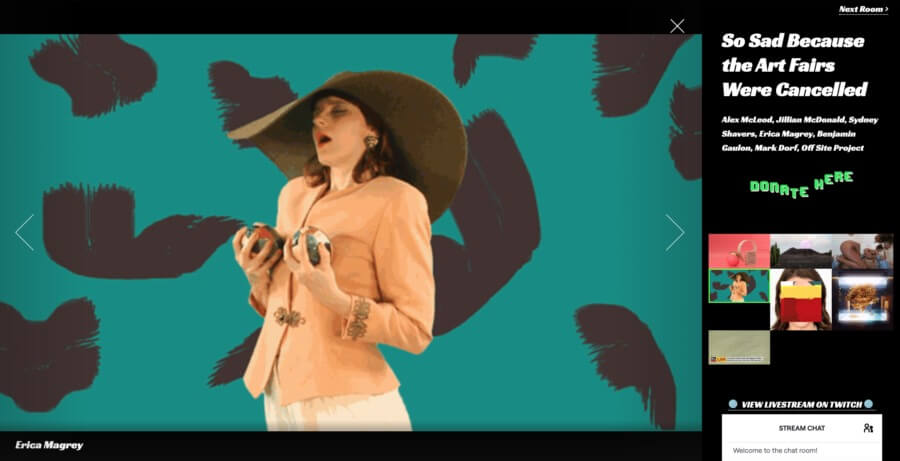
What do you want your audience to walk away with after experiencing your platform?
There are two things two things that I hope a casual browse to Silicon Valet can impart. First and foremost, I want the audience to walk away with a sense of community. I hope that, as we all tinker away on our devices in our isolated environments, that the Valet can help folks feel connected to a wider online world. We often feel like art is far away from us, elevated in some way. I don’t think this is how art should be experienced, and I don’t think that artists and curators should be these distant figures. I hope that Silicon Valet brings these creative moments and innovators within reach.
Second, I want to impart the communicative power of installation documentation! Documentation is often thought of as secondary to a physical installation – an afterthought. Artists and curators need to be thinking about these images as constitutive elements of any art experience, and as direct extensions of the work itself. Why can’t we think of work this way? Why is it wrong, bad, or less than? As a profound believer in the power of simulation to evoke transformative experience, I hope that folks begin to understand how these kinds of images and virtualized documentation can be deeply affective. If all artists, curators, and institutions thought this way, think of the amazing online experiences we could all share together?
Where do you find that the internet and the “real world” overlap?
Everywhere, all over, all the time! Yes, while the Internet and the physical world are both two different material realities, they are both in fact ‘real’. One of my anthropology idols is Tom Boellstorff, who makes a powerful argument that the “virtual” is not opposed to the “real,” but rather to the “actual” (or, physical). Both the virtual and the actual are very real, but constituted through different material conditions.
The online world is all around us, and vice versa. For me, it’s impossible to extricate their effect on one another.
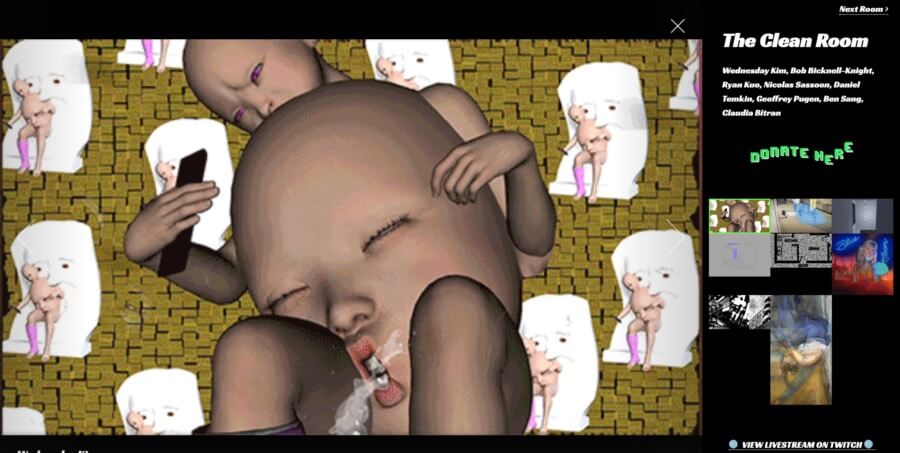
What are your long-term goals for Silicon Valet?
The platform is growing every day! This week our first online exhibition “Well Now WTF?” goes live. We’re launching a ton of interactive programming to accompany the show, and trying tons of stuff that we’ve never done before.
I’m also working with a collaborator of mine, d0n.xyz, on a number of more expansive projects that will be hosted by Silicon Valet. In the coming months, we will be launching an online database of internet-based artworks, an interactive map of digital arts organizations and initiatives across the world, and even a 3D immersive exhibition space.
The sky’s the limit baby, and we’re just getting started.
